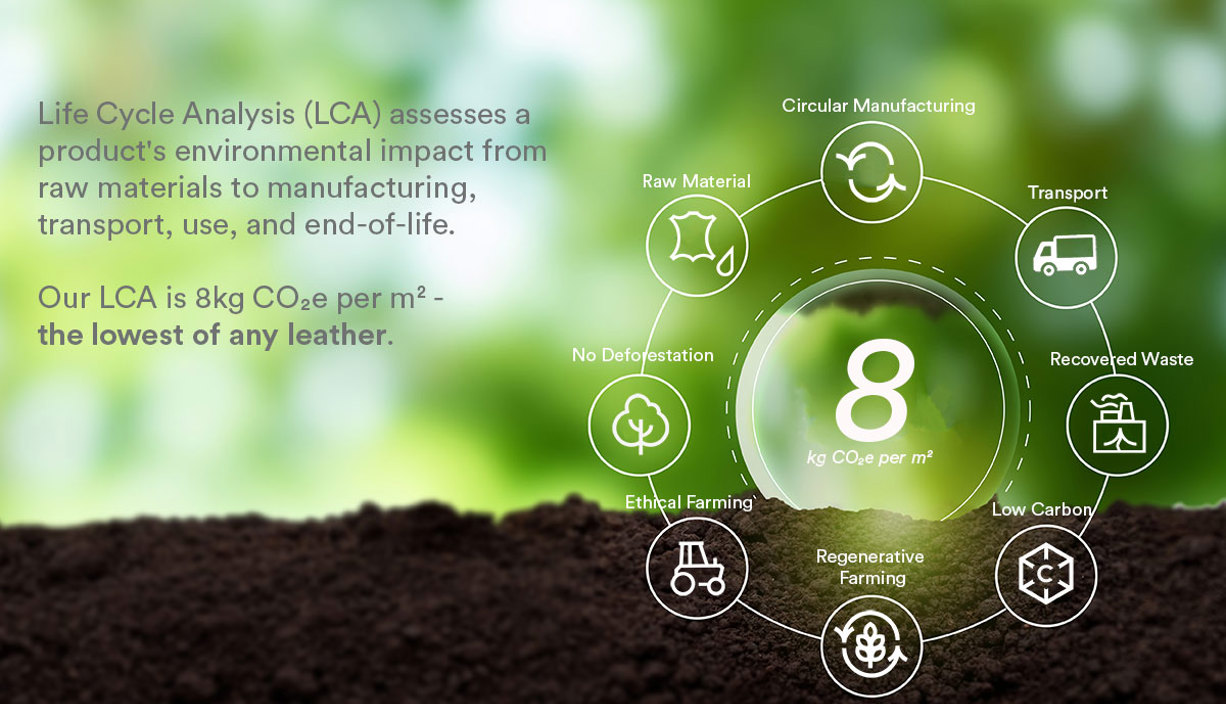
Introduction
Life Cycle Analysis (LCA) may sound like something reserved for scientists in lab coats, but actually, it’s an invaluable tool for anyone aiming to understand and reduce the environmental impacts of their products or services. At its heart, LCA is an environmental impact check, examining every stage of a product’s life — cradle to grave, upstream and downstream.
Muirhead takes pride in leading the way with the world's lowest Life Cycle Analysis (LCA) among high-performance leathers. With a carbon footprint of just 8kg CO₂e per m², we set a global benchmark for environmental performance. The LCA for our leather is based on primary data, independently created by specialist consultants according to ISO 14040 and ISO 14044 using Sector Guidance standards.
Regular review of our supply chains and processes enables us to identify opportunities for continuous improvement, ensuring our steadfast commitment to sustainability evolves alongside innovation.

Q&A: Life Cycle Analysis Demystified
- What exactly is Life Cycle Analysis (LCA)? Life Cycle Analysis (LCA) evaluates the environmental impacts of a product throughout its entire life cycle. From raw material extraction to manufacturing, transport, use, and disposal or recovery, LCA provides a detailed snapshot of a product’s ecological footprint.
- Why should manufacturers care about LCA? For manufacturers, LCA is both a mirror and a map. It details the environmental impact of each production stage and presents opportunities where improvements could be made. The benefits? Reduced waste, lower costs, and an environmentally sustainable brand reputation—all wrapped up in a single package.
- What are the stages of an LCA? An LCA examines the entire journey of a product through distinct stages:
Raw Material Extraction: This is where it all begins. Assessing the environmental impact of sourcing raw materials ensures responsible practices from the start.
Manufacturing and Processing: Transforming raw materials into a finished product can involve significant energy and water consumption.
Transportation: Moving materials and products through the supply chain adds to the carbon footprint — optimising logistics can make a big difference.
Usage: How customers use the product affects its overall environmental impact, particularly for energy-dependent goods.
Disposal and Recovery: The end-of-life stage — including reuse, recovery, and recycling — is crucial for understanding the product’s circularity and long-term impact.
Each stage offers opportunities to minimise impact and decrease emissions, highlighting where businesses can innovate and improve.
- How does LCA combat greenwashing? Greenwashing – giving a false impression of the environmental impacts or benefits of a product, which can mislead consumers — is a growing concern. By relying on fact-based, quantitative assessments, LCA separates genuine environmental efforts from marketing fluff. Always look for third-party verified LCA reports to ensure authenticity.
- What should I look for in a supplier’s LCA report? A reliable LCA report should:
- Cover all life cycle stages (upstream, downstream or consider caveats where not provided).
- Include key aspects like raw materials, energy consumption, transport, and water usage.
- Adhere to ISO standards (14040/14044).
- Be verified by an independent third-party.
Transparency is
key — if it’s not clear where the data comes from, ask questions.
- How can LCA improve product sustainability? LCA can act as a guidebook for sustainable design. For example:
- Sourcing local materials can reduce transportation emissions.
- Switching to recycled i
nputs might lower the overall carbon footprint.
- Are there limitations to LCA? Yes, LCA isn’t perfect. It’s data-intensive and requires detailed information which isn’t always readily available, but with careful application, it remains one of the best tools for measuring and comparing the environmental impacts of a product.
Stay tuned for the next part of this journal, where we will explore the challenges of achieving transparency in LCAs, especially when evaluating synthetic materials, and how upstream, core and downstream activities shape the bigger picture of sustainability.




